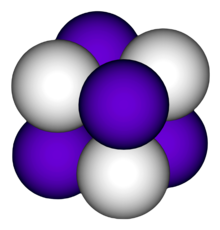 Potassium cation, K+ Hydrogen anion, H− | |
| Names | |
|---|---|
| IUPAC name
Potassium hydride
| |
| Identifiers | |
3D model (JSmol)
|
|
| ChemSpider | |
| ECHA InfoCard | 100.028.823 |
| EC Number |
|
PubChem CID
|
|
CompTox Dashboard (EPA)
|
|
| |
| |
| Properties | |
| KH | |
| Molar mass | 40.1062 g/mol |
| Appearance | white to gray crystalline powder |
| Density | 1.43 g/cm3[1] |
| Melting point | decomposes at ~400 °C[2] |
| reacts | |
| Solubility | insoluble in benzene, diethyl ether, carbon disulfide |
| Structure | |
| cubic, cF8 | |
| Fm3m, No. 225 | |
| Thermochemistry | |
Heat capacity (C)
|
37.91 J/(mol⋅K) |
Std enthalpy of
formation (ΔfH⦵298) |
-57.82 kJ/mol |
| Hazards | |
| Occupational safety and health (OHS/OSH): | |
Main hazards
|
corrosive, pyrophoric, reacts violently with acids and water |
| NFPA 704 (fire diamond) | |
| Related compounds | |
Other cations
|
Lithium hydride Sodium hydride Rubidium hydride Caesium hydride |
Except where otherwise noted, data are given for materials in their standard state (at 25 °C [77 °F], 100 kPa).
| |
Potassium hydride, KH, is the inorganic compound of potassium and hydrogen. It is an alkali metal hydride. It is a white solid, although commercial samples appear gray. It is a powerful superbase that is useful in organic synthesis. It is sold commercially as a slurry (~35%) in mineral oil or sometimes paraffin wax to facilitate dispensing.[3]
Potassium hydride is produced by direct combination of the metal and hydrogen at temperatures between 200 and 350 °C:
This reaction was discovered by Humphry Davy soon after his 1807 discovery of potassium, when he noted that the metal would vaporize in a current of hydrogen when heated just below its boiling point.[4]: p.25
Potassium hydride is soluble in fused hydroxides (such as molten sodium hydroxide) and salt mixtures, but not in organic solvents.[5]
KH reacts with water according to the reaction:
As a superbase, potassium hydride is more basic than sodium hydride. It is used to deprotonate certain carbonyl compounds to give enolates. It also deprotonates amines to give the corresponding amides of the type KNHR and KNR2.[6]
KH can be pyrophoric in air, react violently with acids, and can ignite upon contact with oxidants. As a suspension in mineral oil, KH is less dangerous.